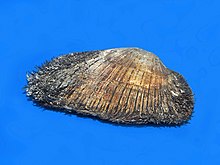| Barbatia barbata | |
|---|---|

| |
| Shell of Barbatia barbata from Sicily at the Museo Civico di Storia Naturale di Milano | |
| Scientific classification | |
| Domain: | Eukaryota |
| Kingdom: | Animalia |
| Phylum: | Mollusca |
| Class: | Bivalvia |
| Order: | Arcida |
| Family: | Arcidae |
| Genus: | Barbatia |
| Species: | B. barbata |
| Binomial name | |
| Barbatia barbata (Linnaeus, 1758) | |
| Synonyms | |
| |
Barbatia barbata is a species of ark clam, a marine bivalve mollusk in the family Arcidae, the ark clams.
Description

The shell of an adult Barbatia barbata can be as large as 35–100 millimetres (1.4–3.9 in). The shape of the shell of this common species is quite variable. Usually it is oblong and flattened, with many radial ribs cut by concentric lines. When alive or fresh dead, the shell has a characteristic hairy dark periostracum (hence the Latin name barbata, meaning "bearded"), covering the entire surface of the shell except for the apical part.
Right and left valve of the same specimen:
Barbatia barbata var elongata
Right and left valve of the same specimen:
Distribution
This ark clam is found along the coasts of the Mediterranean Sea, especially in Greece, Italy and Tunisia.
Habitat
This species lives on rocky or coralligenous (coral-bearing) seabed.
References
- Repetto G., Orlando F. & Arduino G. (2005) - Conchiglie del Mediterraneo - Published by Amici del Museo "Federico Eusebio", Alba, Italy
- Biolib
- WoRMS
- Conchiglie veneziane
| Taxon identifiers | |
|---|---|
| Barbatia barbata | |
This Arcidae-related article is a stub. You can help Misplaced Pages by expanding it. |



